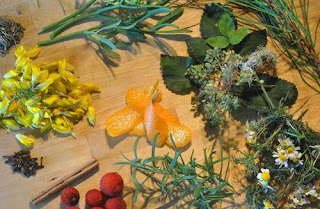We have so much to celebrate and to be proud of as a country at the moment. I am not ashamed to say I'm a royalist and love all the pomp and ceremony we enjoy as a nation. Rule Britania!
Congratulations to Kate and Wills as they celebrate their first wedding anniversary - here's to many more happy years! The Olympics are just around the corner and, of course, we are celebrating our Queen's Diamond Jubilee year.
Here are a few Patriotic Puds to consider for your celebrations - they look and taste fantastic!
Red, White and Blueberry Trifle
Yield: One 9×13-inch pan
1. For each flavor,
dissolve one box of Jelly in 1 cup of boiling water. Pour into a square
container that is about 6 to 8″ square and chill at least 3 hours, or
overnight. (Try to use the same size for all four so that the blocks will come
out the same. In this case the smaller the better – I used 8″ pans and felt my
“blocks” were a little too flat.)
2. After chilling the flavors, cut them into small blocks.
3. Carefully mix the blocks in a 9×13-inch pan.
4. In a separate bowl, sprinkle 2 envelopes of unflavored gelatin into ½ cup cold water. After the gelatin blooms, add 1½ cups boiling water and dissolve. Add the can of condensed milk. Stir and let cool. Pour cooled milk mixture over Jelly blocks in 9×13 pan. Skim off any small bubbles that are created when you pour the condensed milk on the Jelly pieces. Chill overnight or at least 3 hours until firm.
5. Cut into blocks or shapes and serve.
Congratulations to Kate and Wills as they celebrate their first wedding anniversary - here's to many more happy years! The Olympics are just around the corner and, of course, we are celebrating our Queen's Diamond Jubilee year.
Here are a few Patriotic Puds to consider for your celebrations - they look and taste fantastic!
Red, White and Blueberry Trifle
700 g fresh strawberries, divided
500 g fresh blueberries, divided
200 ml berry five fruit blend fruit juice
500 ml double cream, divided
1 pot (450 g) strawberry yogurt
ð
Place Madeira cake on Large Grooved Cutting Board; cut cake into
2.5-cm cubes using Chef’s Knife. Set aside.
ð Set aside 85 g of the strawberries and 55 g
of the blueberries for decoration.
ð In Classic Batter Bowl, combine
remaining strawberries and the fruit juice; stir gently using Small Mix ‘NScraper®.
ð Pour cream into Stainless 4-Litre MixingBowl; whip until cream forms medium-firm peaks.
ð Spoon some of the whipped cream (about
125 g) into Easy Accent® Decorator fitted with open star tip (so
decorator is about two-thirds full); set aside.
ð
Add strawberry yogurt to remaining cream and fold together until
combined using Mix ‘N Scraper®.
ð To assemble trifle, place one-third of the
cake cubes into Trifle Bowl.
ð Top with one-third of the strawberry and
juice mixture and one third of the remaining blueberries, pressing down
lightly. Top with one-third of the yogurt mixture, spreading evenly.
ð Repeat layers twice, spreading last layer
evenly.
ð Decoratively pipe reserved whipped cream over
top of trifle; decorate with reserved berries.
ð Serve immediately or refrigerate until ready
to serve (see Chef’s Corner).
ð Serve.
Serves 16
chef’s corner
This trifle is best served on the day it is made. It can be served
immediately or it can be refrigerated until you are ready to serve. If making
the trifle in advance, once made, refri gerate the trifle for a maximum of 4–6
hours for best results.
You may like to whip the cream in advance. Once whipped, keep the cream
refrigerated until you are ready to use it. The strawberries can also be hulled
in advance, if desired.
Stained Glass Jelly
ð
4
boxes (3-ounces each) Jelly (or store brand gelatin dessert) in different
colors
14-oz can sweetened condensed milk
2 envelopes unflavored gelatin
Water
14-oz can sweetened condensed milk
2 envelopes unflavored gelatin
Water
2. After chilling the flavors, cut them into small blocks.
3. Carefully mix the blocks in a 9×13-inch pan.
4. In a separate bowl, sprinkle 2 envelopes of unflavored gelatin into ½ cup cold water. After the gelatin blooms, add 1½ cups boiling water and dissolve. Add the can of condensed milk. Stir and let cool. Pour cooled milk mixture over Jelly blocks in 9×13 pan. Skim off any small bubbles that are created when you pour the condensed milk on the Jelly pieces. Chill overnight or at least 3 hours until firm.
5. Cut into blocks or shapes and serve.



